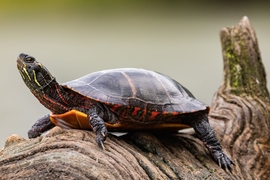In 2020, Kathrin "Kat" Kajderowicz's father passed away from lung cancer. Kajderowicz was in charge of her father's health care for as long as she can remember. While he suffered from various cardiovascular issues for several years, it wasn't until the beginning of the Covid-19 pandemic that he was diagnosed with late-stage metastatic small-cell lung cancer. Jumping into a primary caregiver position, she closely monitored the treatments he received from doctors to no avail. "I was frustrated with the many medications he was prescribed without the doctors fully understanding how they interacted with each other," she says. Even if a single physician had been overseeing his comprehensive treatment plan, she says, they still could not definitively say whether the medication combinations have adverse effects that outweigh any positive impact.
This frustration set her on a scientific journey that has now culminated in her research as a PhD student at MIT's Department of Brain and Cognitive Sciences (BCS) and the Whitehead Institute for Biomedical Research. "My experience led me to a significant medical problem: How can we eventually shift the medical paradigm to develop treatments that consider not only one specific pathway or problem but contextualize systemic tissue or organ dysfunction?"
To engage with this problem, Kajderowicz studies animals uniquely adapted to handle different stressors and environments, possibly modeling human disease states. "Perhaps we can turn to nature and see how different organisms have adapted to overcome and mitigate similar challenges," she says.
Kajderowicz now works in Professor Siniša Hrvatin's lab at Whitehead and the MIT Department of Biology, where she researches cold tolerance. "I'm interested in exploring the mechanisms underlying cellular cold tolerance in hibernating organisms." Engineering cold tolerance and stasis has many potential revolutionary future applications. In the near term, her work could improve organ transplantation and cell or tissue preservation. In the longer term, she hopes her work could catalyze a shift in the medical field away from its current crisis-mode approach: "By slowing down bodily processes and disease progression, a lower metabolic state could pave the way for a new class of hypothermic therapies that induce human hibernation-like states for cells, organs, or even whole organisms."
First-generation student and scientist
Kajderowicz's clearheaded pursuit of fundamental, large-scale scientific questions has propelled her impressive career as a young scientist. Recently, she was awarded the Paul and Daisy Soros Fellowship for New Americans, recognizing her unique path as the daughter of immigrants from Soviet Poland. Her parents arrived in the United States without having completed higher education degrees, without any savings, knowledge of English, medical insurance, or immigration papers. They worked hard to make a living — her father was a construction worker and her mother a housekeeper — using much of their earnings to become naturalized citizens.
Kajderowicz developed an early interest in a scientific career. "My parents, who didn't go to college, didn't push me toward any specific profession," she says. "This gave me the freedom to explore any field I wanted, and my curiosity naturally led me to science."
As a teenager, she worked as a golf caddie to help her parents financially. Clients at the golf course assisted her in obtaining internships at biotech and tech companies. Having won Best in Category at the Illinois State Science Fair, Kajderowicz received a substantial scholarship to support her studies at Cornell University, but she continued working to pay for her expenses and tuition. At Cornell, Kajderowicz joined the renowned Lab of Ornithology, where she applied machine-learning techniques to study songbird communication and other behavioral patterns.
Kajderowicz's journey as a neuroscientist began at Harvard Medical School in Professor Connie Cepko's lab, where she studied the developmental trajectory of a population of retinal interneurons. "Learning how to identify cell signatures was a fascinating introduction to the complexity of life. But I ultimately realized I wanted to pursue the questions that kept me up at night — both how we process information and how and why these processes change during aging. For me, these are life's biggest unanswered questions, and I believe neuroscience is the foundation for everything. This led me to MIT's Department of Brain and Cognitive Sciences."
Learning from hamsters
Kajderowicz applied and was admitted to over two dozen graduate programs — "but I knew I wanted to go to MIT BCS. That was a no-brainer," she says. "The department has faculty members in all levels of neuroscience: the cellular and molecular, systems, computational, and cognitive levels. It's amazing to have all these people under one roof."
Shortly after starting her graduate work at MIT, Kajderowicz realized she wanted to focus on the cellular level. "I think it's important first to understand how things work within cells before focusing on function and systems." She also seeks a translational avenue connecting theory and therapy, bridging the gap between basic science and applied treatment.
Kajderowicz found what she sought at the Whitehead Institute's Hrvatin Lab and Weissman Lab. "It's truly unique to have access to two very different communities at MIT. In BCS, I am seen as a biologist, while at the Whitehead Institute, I am more of a neuroscientist. It's great having folks from different training backgrounds challenging my ideas and work."
Instead of working directly on how cognition is encoded at the cellular level, Kajderowicz decided to embark on a project that would allow her to figure out how different species survive extreme stressors and environments. She is now developing tools to study cold tolerance across several species on the cellular level.
"Hibernating hamsters can safely endure prolonged durations during which their body temperature drops to 4 degrees [Celsius]. By taking a comparative species approach, I want to identify whether hibernators are uniquely genetically programmed to withstand these conditions or whether non-hibernators don't activate these genetic pathways," she says. Next, Kajderowicz hopes to figure out how to transfer or activate cold-protective effects to human cells and, someday, whole humans. While she isn't directly studying the root of cognition, she hopes her research will help maintain or enhance cognitive functioning throughout aging by pushing the boundaries of the types of medicines and therapeutics available.
Building a scientific community
Kajderowicz's involvement in the scientific community extends beyond her immediate work. At the height of the pandemic, she initiated a digital platform facilitating conversations on biotechnology trends among researchers, biotech professionals, venture capitalists, and others interested in staying updated on cutting-edge developments. Known as "DNA Deviants," the community she built consists of several thousand active members on several social media platforms.
"It started with an informal journal club I had with some friends, where we would meet over coffee and discuss new papers. Then, when the pandemic shut down everything, I started a real-time podcast on the Clubhouse app with a friend, discussing emerging biotech trends. Eventually, it became an online journal club, and people just kept joining. We got experts to serendipitously join conversations within their realm of expertise from around the world." Today, almost a dozen PhD, MD-PhD, and motivated undergraduates worldwide take turns leading conversations with different paper authors.
"It's been incredibly rewarding to remain connected not only to my work, but also to gain a comprehensive understanding of what's happening in the world," Kajderowicz says. "You always need to look beyond your immediate circle."








